Relationship between Fire Events and Land Use Changes in the State of São Paulo, Brazil
Abstract
:1. Introduction
2. Materials and Methods
2.1. Study Area and Economic Data
2.2. Google Earth Engine
2.2.1. MapBiomas
2.2.2. Fire Count Data
2.3. Statistical Analysis
3. Results
3.1. Land Use Changes
3.2. Fire Event Impact
3.3. Statistical Analysis
4. Discussion
5. Conclusions
Limitations and Future Work
Supplementary Materials
Author Contributions
Funding
Institutional Review Board Statement
Informed Consent Statement
Data Availability Statement
Acknowledgments
Conflicts of Interest
References
- Morton, D.C.; Defries, R.S.; Randerson, J.T.; Giglio, L.; Schroeder, W.; Van Der Werf, G.R. Agricultural intensification increases deforestation fire activity in Amazonia: Deforestation fires in Amazonia. Glob. Change Biol. 2008, 14, 2262–2275. [Google Scholar] [CrossRef] [Green Version]
- Simoes, R.; Picoli, M.C.A.; Camara, G.; Maciel, A.; Santos, L.; Andrade, P.R.; Sánchez, A.; Ferreira, K.; Carvalho, A. Land use and cover maps for Mato Grosso state in Brazil from 2001 to 2017. Sci. Data 2020, 7. [Google Scholar] [CrossRef] [PubMed] [Green Version]
- Souza, C.M.Z.; Shimbo, J.; Rosa, M.R.; Parente, L.L.A.; Alencar, A.; Rudorff, B.F.T.; Hasenack, H.; Matsumoto, M.G.; Ferreira, L.; Souza-Filho, P.W.M.; et al. Reconstructing three decades of land use and land cover changes in Brazilian biomes with Landsat archive and Earth Engine. Remote Sens. 2020, 12, 2735. [Google Scholar] [CrossRef]
- De Moraes, M.C.P.; de Mello, K.; Toppa, R.H. Protected areas and agricultural expansion: Biodiversity conservation versus economic growth in the southeast of Brazil. J. Environ. Manag. 2017, 188, 73–84. [Google Scholar] [CrossRef]
- Trindade, M.B.; Lins-e-Silva, A.C.B.; Silva, H.D.; Figueira, S.B.; Schessl, M. Fragmentation of the Atlantic Rainforest in the northern coastal region of Pernambuco, Brazil: Recent changes and implications for conservation. Biorem. Biodivers. Bioavailab. 2008, 2, 5–13. Available online: http://www.globalsciencebooks.info/Online/GSBOnline/images/0812/BBB_2(SI1)/BBB_2(SI1)5-13o.pdf (accessed on 30 June 2021).
- Teixeira, A.M.G.; Soares-Filho, B.S.; Freitas, S.R.; Metzger, J.P. Modeling landscape dynamics in an Atlantic Rainforest region: Implications for conservation. For. Ecol. Manag. 2009, 257, 1219–1230. [Google Scholar] [CrossRef]
- Lira, P.K.; Tambosi, L.R.; Ewers, R.M.; Metzger, J.P. Land-Use and land-cover change in Atlantic Forest landscapes. For. Ecol. Manag. 2012, 278, 80–89. [Google Scholar] [CrossRef]
- Ribeiro, M.C.; Metzger, J.P.; Martensen, A.C.; Ponzoni, F.J.; Hirota, M.M. The Brazilian Atlantic Forest: How much is left, and how is the remaining forest distributed? Implications for conservation. Biol. Conserv. 2009, 142, 1141–1153. [Google Scholar] [CrossRef]
- Tabarelli, M.; Pinto, L.P.; Silva, J.M.C.; Hirota, M.; Bede, L. Challenges and opportunities for biodiversity conservation in the Brazilian Atlantic Forest. Conserv. Biol. 2005, 19, 695–700. [Google Scholar] [CrossRef]
- Butler, R.A. Brazil’s Forests. Mongabay. 2020. Available online: https://rainforests.mongabay.com/brazil/ (accessed on 15 October 2020).
- Salemi, L.F.; Groppo, J.D.; Trevisan, R.; de Moraes, J.M.; de Barros Ferraz, S.F.; Villani, J.P.; Duarte-Neto, P.J.; Martinelli, L.A. Land-use change in the Atlantic rainforest region: Consequences for the hydrology of small catchments. J. Hydrol. 2013, 499, 100–109. [Google Scholar] [CrossRef]
- de Oliveira, G.; Moraes, E.C.; Brunsell, N.A.; Shimabukuro, Y.E.; Mataveli, G.A.V.; dos Santos, T.V. Analysis of precipitation and evapotranspiration in Atlantic Rainforest remnants in southeastern Brazil from remote sensing data. In Tropical Forests—The Challenges of Maintaining Ecosystem Services while Managing the Landscape; Blanco, J.A., Chang, S.-C., Lo, Y.-H., Eds.; IntechOpen: London, UK, 2016; pp. 93–112. [Google Scholar] [CrossRef] [Green Version]
- Ribeiro, M.C.; Martensen, A.C.; Metzger, J.P.; Tabarelli, M.; Scarano, F.; Fortin, M.-J. The Brazilian Atlantic forest: A shrinking biodiversity hotspot. In Biodiversity Hotspots; Zachos, F.E., Habel, J.C., Eds.; Springer: Berlin/Heidelberg, Germany, 2011; pp. 405–434. [Google Scholar] [CrossRef]
- Fundación Vida Silvestre Argentina & WWF. State of the Atlantic Forest: Three countries, 148 million people, one of the richest forests on earth. 2017. Available online: http://awsassets.panda.org/downloads/documento_fvs_baja.pdf (accessed on 8 April 2021).
- Government of the State of São Paulo Secretary of the Environment (SMA). Action Plan of the State of São Paulo—SMA Component Aichi Targets 2020 Implementation in the State of São Paulo. Strategic Plan for Biodiversity 2011–2020. Convention on Biological Diversity. 2013. Available online: smastr16.blob.core.windows.net/english/2015/04/Aichi_impressao_21_2_14_pdf_ENG_V.pdf (accessed on 28 June 2021).
- Santana, C.A.M.; Nascimento, J.R. Public policies and agricultural investment in Brazil (Final Report). Food and Agriculture Organization of the United Nations Policy Assistance Support. Service (TCSP). 2012. Available online: www.fao.org/fileadmin/templates/tci/pdf/InvestmentPolicy/Inv_in_Br_agriculture_-_20_08_2012.pdf (accessed on 29 June 2021).
- Alkimim, A.; Sparovek, G.; Clarke, K.C. Converting Brazil’s pastures to cropland: An alternative way to meet sugarcane demand and to spare forestlands. Appl. Geogr. 2015, 62, 75–84. [Google Scholar] [CrossRef]
- Kronka, F.J.N.; Nalon, M.A.; Matsukuma, C.K.; Kanashiro, M.M.; Ywane, M.S.S.; Pavão, M.; Durigan, G.; Lima, L.M.P.R.; Guillaumon, J.R.; Baitello, J.B.; et al. Forest Inventory of the Natural Vegetation in São Paulo State. [Inventário florestal da vegetação natural do estado de São Paulo.] Secretaria de Infraestrutura e Meio Ambiente|Instituto Florestal. 2005. Available online: www.infraestruturameioambiente.sp.gov.br/institutoflorestal/2005/03/inventario-florestal-da-vegetacao-natural-do-estado-de-sao-paulo/ (accessed on 20 September 2020).
- Vera, I.; Wicke, B.; van der Hilst, F. Spatial variation in environmental impacts of sugarcane expansion in Brazil. Land 2020, 9, 397. [Google Scholar] [CrossRef]
- Lucon, O.; Goldemberg, J. São Paulo—The “other” Brazil: Different pathways on climate change for state and federal governments. J. Environ. Dev. 2010, 19, 335–357. [Google Scholar] [CrossRef]
- Cláudio da Silva, M.; Scarano, F.R.; de Souza Cardel, F. Regeneration of an Atlantic Forest formation in the understorey of a eucalyptus grandis plantation in South-Eastern Brazil. J. Trop. Ecol. 1995, 11, 147–152. [Google Scholar] [CrossRef]
- Pachenco, R.; Silva, R.R.; Morini, M.S.D.C.; Brandão, C.R.F. A Comparison of the Leaf-Litter Ant Fauna in a Secondary Atlantic Forest with an Adjacent Pine Plantation in Southeastern Brazil. Neotrop. Entomol. 2009, 38, 55–65. Available online: www.scielo.br/j/ne/a/KFFnCvxtgjwVjfHLtDk9nxC/?lang=enformat=pdf (accessed on 20 September 2020). [CrossRef] [PubMed] [Green Version]
- Sansevero, J.B.B.; Prieto, P.V.; de Moraes, L.F.D.; Rodrigues, P.J.P. Natural regeneration in plantations of native trees in lowland Brazilian Atlantic forest: Community structure, diversity, and dispersal syndromes. Restor. Ecol. 2011, 19, 379–389. [Google Scholar] [CrossRef]
- Miccolis, M.; Teixeira de Andrade, R.M.; Pacheco, P. Land-use trends and environmental governance policies in Brazil: Paths forward for sustainability. Working paper. Center for International Forestry Research (CIFOR). 2014. Available online: https://www.cifor.org/publications/pdf_files/WPapers/WP171Pacheco.pdf (accessed on 30 June 2021).
- Fanin, T.; van der Werf, G.R. Relationships between burned area, forest cover loss, and land cover change in the Brazilian Amazon based on satellite data. Biogeosciences 2015, 12, 6033–6043. [Google Scholar] [CrossRef] [Green Version]
- Tsao, C.-C.; Campbell, J.E.; Mena-Carrasco, M.; Spak, S.N.; Carmichael, G.R.; Chen, Y. Increased estimates of air-pollution emissions from Brazilian sugar-cane Ethanol. Nat. Clim. Change 2012, 2, 53–57. [Google Scholar] [CrossRef]
- Arbex, M.A.; Martins, L.C.; de Oliveira, R.C.; Pereira, L.A.A.; Arbex, F.F.; Cancado, J.E.D.; Saldiva, P.H.N.; Braga, A.L.F. Air pollution from biomass burning and asthma hospital admissions in a sugar cane plantation area in Brazil. J. Epidemiol. Comm. Health 2007, 61, 395–400. [Google Scholar] [CrossRef] [Green Version]
- Arbex, M.A.; Böhm, G.M.; Saldiva, P.H.N.; Conceição, G.M.S.; Iii, A.C.P.; Braga, A.L.F. Assessment of the effects of sugar cane plantation burning on daily counts of inhalation therapy. J. Air Waste Manage. Assoc. 2000, 50, 1745–1749. [Google Scholar] [CrossRef]
- De, S. Paraiso, M.L.; Gouveia, N. Health risks due to pre-harvesting sugarcane burning in São Paulo State, Brazil. Rev. Bras. Epidemiol. 2015, 18, 691–701. [Google Scholar] [CrossRef] [Green Version]
- Uriarte, M.; Yackulic, C.B.; Cooper, T.; Flynn, D.; Cortes, M.; Crk, T.; Cullman, G.; McGinty, M.; Sircely, J. Expansion of sugarcane production in São Paulo, Brazil: Implications for fire occurrence and respiratory health. Agr. Ecosyst. Environ. 2009, 132, 48–56. [Google Scholar] [CrossRef]
- Nicolella, A.C.; Belluzzo, W. The effect of reducing the pre-harvest burning of sugar cane on respiratory health in Brazil. Environ. Dev. Econ. 2015, 20, 127–140. [Google Scholar] [CrossRef]
- Pedroso-Junior, N.; Adams, C.; Murrieta, R. Slash-and-burn agriculture: A system in transformation. In Current Trends in Human Ecology; Lopes, P., Begossi, A., Eds.; Cambridge Scholars Publishing: Newcastle upon Tyne, UK, 2009; pp. 12–34. Available online: www.researchgate.net/publication/280839609_Slash-and-Burn_Agriculture_A_System_in_Transformation (accessed on 30 November 2020).
- Sloan, S.; Locatelli, B.; Wooster, M.J.; Gaveau, D.L.A. Fire activity in Borneo driven by industrial land conversion and drought during El Niño periods, 1982–2010. Glob. Environ. Change 2017, 47, 95–109. [Google Scholar] [CrossRef] [Green Version]
- Suyanto, S.; Applegate, G.; Permana, R.P.; Khususiyah, N.; Kurniawan, I. The role of fire in changing land use and livelihoods in Riau-Sumatra. Ecol. Soc. 2004, 9, 15. [Google Scholar] [CrossRef]
- Cochrane, M.A.; Laurance, W.F. Synergisms among fire, land use, and climate change in the Amazon. Ambio 2008, 37, 522–527. Available online: https://www.jstor.org/stable/25547943 (accessed on 14 April 2021). [CrossRef] [PubMed]
- Lima, A.; Silva, T.S.F.; de Aragão, L.E.O.e.C.; de Feitas, R.M.; Adami, M.; Formaggio, A.R.; Shimabukuro, Y.E. Land use and land cover changes determine the spatial relationship between fire and deforestation in the Brazilian Amazon. Appl. Geogr. 2012, 34, 239–246. [Google Scholar] [CrossRef]
- Machado Pinheiro, É.F.; Lima, E.; Ceddia, M.B.; Urquiaga, S.; Alves, B.J.R.; Boddey, R.M. Impact of pre-harvest burning versus trash conservation on soil carbon and nitrogen stocks on a sugarcane plantation in the brazilian atlantic forest region. Plant. Soil 2010, 333, 71–80. [Google Scholar] [CrossRef]
- Venkataraman, C.; Habib, G.; Kadamba, D.; Shrivastava, M.; Leon, J.-F.; Crouzille, B.; Boucher, O.; Streets, D.G. Emissions from open biomass burning in India: Integrating the inventory approach with high-resolution Moderate Resolution Imaging Spectroradiometer (MODIS) active-fire and land cover data. Global Biogeochem. Cycles 2006, 20. [Google Scholar] [CrossRef]
- Baguant, J. Electricity production from the biomass of the sugarcane industry in Mauritius. Biomass 1984, 5, 283–297. [Google Scholar] [CrossRef]
- Sornpoon, W.; Bonnet, S.; Kasemsap, P.; Prasertsak, P.; Garivait, S. Estimation of emissions from sugarcane field burning in Thailand using bottom-up country-specific activity data. Atmosphere 2014, 5, 669–685. [Google Scholar] [CrossRef] [Green Version]
- Devineau, J.-L.; Fournier, A.; Nignan, S. Savanna fire regimes assessment with MODIS fire data: Their relationship to land cover and plant species distribution in Western Burkina Faso (West Africa). J. Arid Environ. 2010, 74, 1092–1101. [Google Scholar] [CrossRef] [Green Version]
- Langner, A.; Miettinen, J.; Siegert, F. Land cover change 2002–2005 in Borneo and the role of fire derived from MODIS imagery. Global Change Biol. 2007, 13, 2329–2340. [Google Scholar] [CrossRef]
- Zhan, X.; Sohlberg, R.A.; Townshend, J.R.G.; DiMiceli, C.; Carroll, M.L.; Eastman, J.C.; Hansen, M.C.; DeFries, R.S. Detection of land cover changes using MODIS 250 m data. Remote Sens. Environ. 2002, 83, 336–350. [Google Scholar] [CrossRef]
- Seydi, S.T.; Akhoondzadeh, M.; Amani, M.; Mahdavi, S. Wildfire damage assessment over Australia using Sentinel-2 imagery and MODIS land cover product within the Google Earth Engine cloud platform. Remote Sens. 2021, 13, 220. [Google Scholar] [CrossRef]
- Shock, C.C.; Williams, W.A. Pastures and their management in South-Central Brazil. Pesq. Agropec. Bras. 1977, 12, 105–118. Available online: https://ainfo.cnptia.embrapa.br/digital/bitstream/item/197556/1/Pastures-and-their-management.pdf (accessed on 11 December 2020).
- Brazilian Institute of Geography and Statistics (IBGE). Gross Domestic Product of Municipalities: Complete Tables Dataset. 2018. Available online: https://ftp.ibge.gov.br/Pib_Municipios/2018/xlsx/tabelas_completas.xlsx (accessed on 20 October 2020).
- Johnston, M. Fundamentals of how Brazil Makes its Money. Investopedia. 2019. Available online: www.investopedia.com/articles/investing/050815/fundamentals-how-brazil-makes-its-money.asp (accessed on 1 July 2021).
- Valdes, C. Brazil’s Ethanol Industry: Looking Forward. United States Department of Agriculture Bioenergy No. (BIO-02). Available online: www.ers.usda.gov/webdocs/outlooks/35828/7395_bio02.pdf?v=8420.6 (accessed on 1 July 2021).
- United States Department of Agriculture Foreign Agricultural Service—Global Agricultural Information Network (USDA-GAIN). Brazil: SUGAR ANNUAL. 2019. Available online: apps.fas.usda.gov/newgainapi/api/report/downloadreportbyfilename?filename=SugarAnnual_SaoPauloATO_Brazil_4-15-2019.pdf (accessed on 1 July 2021).
- Chagas, A.; Toneto, R., Jr.; Azzoni, C. The expansion of sugarcane cultivation and its impact on municipal revenues: An application of dynamic spatial panels to municipalities in the state of São Paulo, Brazil. In Energy, BioFuels and Development; Routledge: Abingdon-on-Thames, UK, 2011; pp. 316–338. [Google Scholar] [CrossRef]
- Sampaio, I.L.M.; Cardoso, T.F.; Souza, N.R.D.; Watanabe, M.D.B.; Carvalho, D.J.; Bonomi, A.; Junqueira, T.L. Electricity production from sugarcane straw recovered through bale system: Assessment of retrofit projects. Bioenerg. Res. 2019, 12, 865–877. [Google Scholar] [CrossRef] [Green Version]
- Investe São Paulo. Business Sector: Sugarcane. Available online: www.en.investe.sp.gov.br/business-sectors/agribusiness/sugar-cane/ (accessed on 3 July 2021).
- Sparovek, G.; Barretto, A.; Berndes, G.; Martins, S.; Maule, R. Environmental, land-use and economic implications of Brazilian sugarcane expansion 1996–2006. Mitig. Adapt. Strateg. Glob. Change 2009, 14, 285–298. [Google Scholar] [CrossRef]
- Satolo, L.; Bacchi, M. Impacts of the recent expansion of the sugarcane sector on municipal per capita income in São Paulo State. ISRN Econ. 2013, 2013, 1–14. [Google Scholar] [CrossRef] [Green Version]
- Caldarelli, C.E.; Moraes, M.A.F.D.D.; Paschoalino, P.A.T. Sugarcane ethanol industry effects on the GDP per capita in the center-south region of Brazil. REA 2017, 15, 183–200. [Google Scholar] [CrossRef]
- Chen, C.; He, X.; Liu, Z.; Sun, W.; Dong, H.; Chu, Y. Analysis of regional economic development based on land use and land cover change information derived from Landsat imagery. Sci. Rep. 2020, 10, 12721. [Google Scholar] [CrossRef]
- Sutton, P.C.; Costanza, R. Global estimates of market and non-market values derived from nighttime satellite imagery, land cover, and ecosystem service valuation. Ecol. Econ. 2002, 41, 509–527. [Google Scholar] [CrossRef]
- Henderson, J.V.; Storeygard, A.; Weil, D.N. Measuring economic growth from outer space. Am. Econ. Rev. 2012, 102, 994–1028. [Google Scholar] [CrossRef] [PubMed] [Green Version]
- Kavats, O.; Khramov, D.; Sergieieva, K.; Vasyliev, V. Monitoring of sugarcane harvest in Brazil based on Optical and SAR data. Remote Sens. 2020, 12, 4080. [Google Scholar] [CrossRef]
- Magalhães, P.S.G.; Cerri, D.G.P. Yield Monitoring of Sugar Cane. Biosyst. Eng. 2007, 96, 1–6. [Google Scholar] [CrossRef]
- McCarty, J.L.; Justice, C.O.; Korontzi, S. Agricultural burning in the Southeastern United States detected by MODIS. Remote Sens. Environ. 2007, 108, 151–162. [Google Scholar] [CrossRef]
- Brazilian Institute of Geography and Statistics (IBGE). Brazilian Government Cities@ [Cidades@] Portal: São Paulo—Code: 35 Dataset. Available online: www.ibge.gov.br/en/cities-and-states/sp/.html? (accessed on 14 April 2021).
- Demographia World Urban Areas, 16th ed.; 2021. Available online: http://www.demographia.com/db-worldua.pdf (accessed on 21 December 2020).
- Aguiar, D.A.; Rudorff, B.F.T.; Silva, W.F.; Adami, M.; Mello, M.P. Remote sensing images in support of environmental protocol: Monitoring the sugarcane harvest in São Paulo State, Brazil. Remote Sens. 2011, 3, 2682–2703. [Google Scholar] [CrossRef] [Green Version]
- Investe São Paulo. Diversified Economy: GDP. 2021. Available online: https://www.en.investe.sp.gov.br/why-sao-paulo/diversified-economy/gdp/ (accessed on 1 July 2021).
- Costa, S. São Paulo—Overview. 2021. Available online: https://www.deik.org.tr/uploads/sao-paulo-bilgi-notu.pdf (accessed on 1 July 2021).
- Brazilian Institute of Geography and Statistics (IBGE). GDP of Municipalities: Agriculture Represents More than Half of Economic Activity in 1135 Municipalities. 2016. Available online: https://censo2010.ibge.gov.br/en/noticias-censo.html?view=noticia&id=1&idnoticia=3343&busca=1&t=gdp-of-municipalities-agriculture-represents-more-than-half-economic-activity-in-1 (accessed on 20 October 2020).
- Alisson, E.; Arantes, J.T. Agricultural Output in São Paulo State Grew More than 90% in Last Two Decades. Agência FAPESP. 2016. Available online: https://agencia.fapesp.br/agricultural-output-in-São-paulo-state-grew-more-than-90-in-last-two-decades/24151/ (accessed on 19 October 2020).
- Hansen, M.C.; Potapov, P.V.; Moore, R.; Hancher, M.; Turubanova, S.A.; Tyukavina, A.; Thau, D.; Stehman, S.V.; Goetz, S.J.; Loveland, T.R.; et al. High-resolution global maps of 21st-century forest cover change. Science 2013, 342, 850–853. [Google Scholar] [CrossRef] [Green Version]
- Nyland, K.E.; Gunn, G.E.; Shiklomanov, N.I.; Engstrom, R.N.; Streletskiy, D.A. Land cover change in the lower Yenisei River using dense stacking of Landsat imagery in Google Earth Engine. Remote Sens. 2018, 10, 1226. [Google Scholar] [CrossRef] [Green Version]
- Food and Agriculture Organization of the United Nations (FAO). Global Administrative Unit Layers (GAUL). FAO Map Catalog. 2014. Available online: https://data.apps.fao.org:/map/catalog/srv/api/records/9c35ba10-5649-41c8-bdfc-eb78e9e65654 (accessed on 21 December 2020).
- Mapbiomas Brasil. Project. Available online: https://mapbiomas.org/en/project (accessed on 14 December 2020).
- Giglio, L.; Justice, C.; Boschetti, L.; Roy, D. MCD64A1 MODIS/Terra+Aqua Burned Area Monthly L3 global 500m SIN grid V006 [Dataset]. NASA EOSDIS Land Processes DAAC. 2015. Available online: https://doi:10.5067/MODIS/MCD64A1.006 (accessed on 18 October 2020). [CrossRef]
- Giglio, L.; Schroeder, W.; Hall, J.V.; Justice, C.O. MODIS Collection 6 Active Fire Product User’s Guide Revision C. 2020. Available online: https://modis-fire.umd.edu/files/MODIS_C6_Fire_User_Guide_C.pdf (accessed on 18 October 2020).
- Boschetti, L.; Roy, D.P.; Giglio, L.; Huang, H.; Zubkova, M.; Humber, M.L. Global validation of the collection 6 MODIS burned area product. Remote Sens. Environ. 2019, 235, 111490. [Google Scholar] [CrossRef]
- USDA—GAIN. Brazil: Sugar Annual 2005. Available online: https://apps.fas.usda.gov/newgainapi/api/Report/DownloadReportByFileName?fileName=Annual%20Report_Sao%20Paulo%20ATO_Brazil_04-28-2005 (accessed on 1 July 2021).
- USDA—GAIN. Brazil: Sugar Annual 2010. Available online: https://apps.fas.usda.gov/newgainapi/api/report/downloadreportbyfilename?filename=Sugar%20Annual_Sao%20Paulo%20ATO_Brazil_4-12-2010.pdf (accessed on 1 July 2021).
- USDA—GAIN. Brazil: Sugar Annual 2016. Available online: https://apps.fas.usda.gov/newgainapi/api/report/downloadreportbyfilename?filename=Sugar%20Annual_Sao%20Paulo%20ATO_Brazil_4-15-2016.pdf (accessed on 1 July 2021).
- Rudorff, B.F.T.; Aguiar, D.A.; Silva, W.F.; Sugawara, L.M.; Adami, M.; Moreira, M.A. Studies on the rapid expansion of sugarcane for ethanol production in São Paulo state (Brazil) using Landsat data. Remote Sens. 2010, 2, 1057–1076. [Google Scholar] [CrossRef] [Green Version]
- Oliveira, J.C.; Lamparelli, R.A.C.; Figueiredo, G.K.D.A.; Campbell, E.E.; Soares, J.R.; Monteiro, L.A.; Vianna, M.; Jaiswal, D.; Bonamigo, A.F.C.; Sheehan, J.J.; et al. Pasture land cover change in São Paulo state, Brazil. Int. Arch. Photogramm. Remote Sens. Spatial Inf. Sci. 2020, XLII-3/W12-2020, 321–326. [Google Scholar] [CrossRef]
- Observatório da Cana. Production and Milling History. Available online: https://observatoriodacana.com.br/historico-de-producao-e-moagem.php?idMn=31&tipoHistorico=2 (accessed on 3 July 2021).
- De Barros, J.R.M.; The Impact of the International Financial Crisis on Brazil (ARI). Area: International Cooperation & Development. 2010. Available online: www.realinstitutoelcano.org/wps/wcm/connect/657b82004218865b8c0cee8b6be8b54b/ARI38-2010_MendocadeBarros_Impact_International_Financial_Crisis_Brazil.pdf?CACHEID=657b82004218865b8c0cee8b6be8b54b&MOD=AJPERES (accessed on 14 April 2021).
- Cascione, S. Brazil’s Worst-Ever Recession Unexpectedly Deepens in Late 2016. Reuters. 2017. Available online: https://www.reuters.com/article/us-brazil-economy-gdp-idUSKBN16E1EL (accessed on 4 March 2021).
- Sobreira, R.; de Paula, L.F. The 2008 financial crisis and banking behavior in Brazil: The role of the prudential regulation. J. Innov. Econ. 2010, 6, 77–93. [Google Scholar] [CrossRef]
- De, O.; Bordonal, R.; Carvalho, J.L.N.; Lal, R.; de Figueiredo, E.B.; de Oliveira, B.G.; La Scala, N. Sustainability of sugarcane production in Brazil. A review. Agron. Sustain. Dev. 2018, 38, 13. [Google Scholar] [CrossRef] [Green Version]
- Parente, L.; Mesquita, V.; Miziara, F.; Baumann, L.; Ferreira, L. Assessing the pasturelands and livestock dynamics in Brazil, from 1985 to 2017: A novel approach based on high spatial resolution imagery and Google Earth Engine cloud computing. Remote Sens. Environ. 2019, 232, 111301. [Google Scholar] [CrossRef]
- Apex-Brasil. Brazil Leverages Breakthroughs in Technology, Productivity and Safety to Lead Global Agriculture and Livestock Market Amid COVID-19. Available online: https://www.prnewswire.com/news-releases/brazil-leverages-breakthroughs-in-technology-productivity-and-safety-to-lead-global-agriculture-and-livestock-market-amid-covid-19-301102477.html (accessed on 14 April 2021).
- Assunção, J.J.; Bragança, A.; Hemsley, P. High Productivity Agricultural Techniques in Brazil. Climate Policy Institute. 2013. Available online: https://www.climatepolicyinitiative.org/publication/high-productivity-agricultural-techniques-in-brazil-adoption-barriers-and-potential-solutions/ (accessed on 17 March 2021).
- CEPEA—Center for Advanced Studies on Applied Economics. Areas With Pasture Reduce, But Yield Increases. Available online: https://www.cepea.esalq.usp.br/en/brazilian-agribusiness-news/areas-with-pasture-reduce-but-yield-increases.aspx (accessed on 23 March 2021).
- Leite, M.R.; Zanetta, D.M.T.; Trevisan, I.B.; de, A.; Burdmann, E.; de P. Santos, U. Sugarcane cutting work, risks, and health effects: A literature review. Rev. Saúde Pública 2018, 52, 80. [Google Scholar] [CrossRef] [Green Version]
- Dos, S.; Costa, A.; Malhado, A.C.M.; Bragagnolo, C.; Correia, R.A.; Ladle, R.J. Ecological outcomes of Atlantic Forest restoration initiatives by sugar cane producers. Land Use Policy 2016, 52, 345–352. [Google Scholar] [CrossRef]
- Rachid, C.T.C.C.; Santos, A.L.; Piccolo, M.C.; Balieiro, F.C.; Coutinho, H.L.C.; Peixoto, R.S.; Tiedje, J.M.; Rosado, A.S. Effect of sugarcane burning or green harvest methods on the Brazilian Cerrado soil bacterial community structure. PLoS ONE 2013, 8, e59342. [Google Scholar] [CrossRef]
- Institute of Agricultural Economics (IEA). Ethanol in the State of São Paulo. 2007. Available online: http://www.iea.sp.gov.br/bioe/bio-english-1.pdf (accessed on 30 June 2021).
- UNICA (Brazilian Sugarcane Industry Association). Sustainability. Available online: https://observatoriodacana.com.br/ (accessed on 30 June 2021).
- D’Anunciação, P.E.R.; Silva, M.F.V.; Ferrante, L.; Assis, D.S.; Casagrande, T.; Coelho, A.Z.G.; Amâncio, B.C.S.; Pereira, T.R.; da Silva, V.X. Forest fragments surrounded by sugar cane are more inhospitable to terrestrial amphibian abundance than fragments surrounded by pasture. Int. J. Ecol. 2013, 2013, 1–8. [Google Scholar] [CrossRef]
- França, D.; Longo, K.; Rudorff, B.; Aguiar, D.; Freitas, S.; Stockler, R.; Pereira, G. Pre-harvest sugarcane burning emission inventories based on remote sensing data in the state of São Paulo, Brazil. Atmos. Environ. 2014, 99, 446–456. [Google Scholar] [CrossRef]

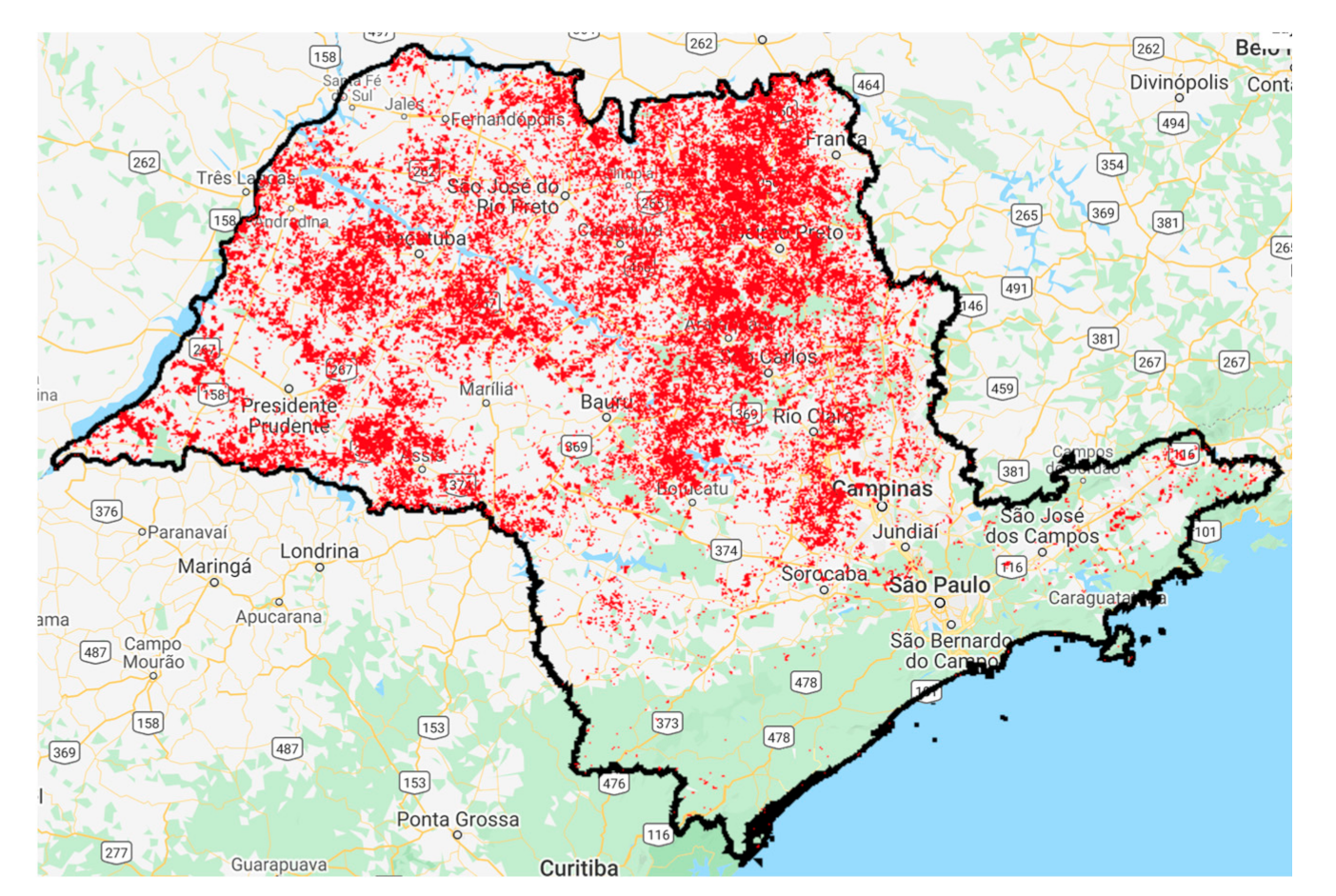
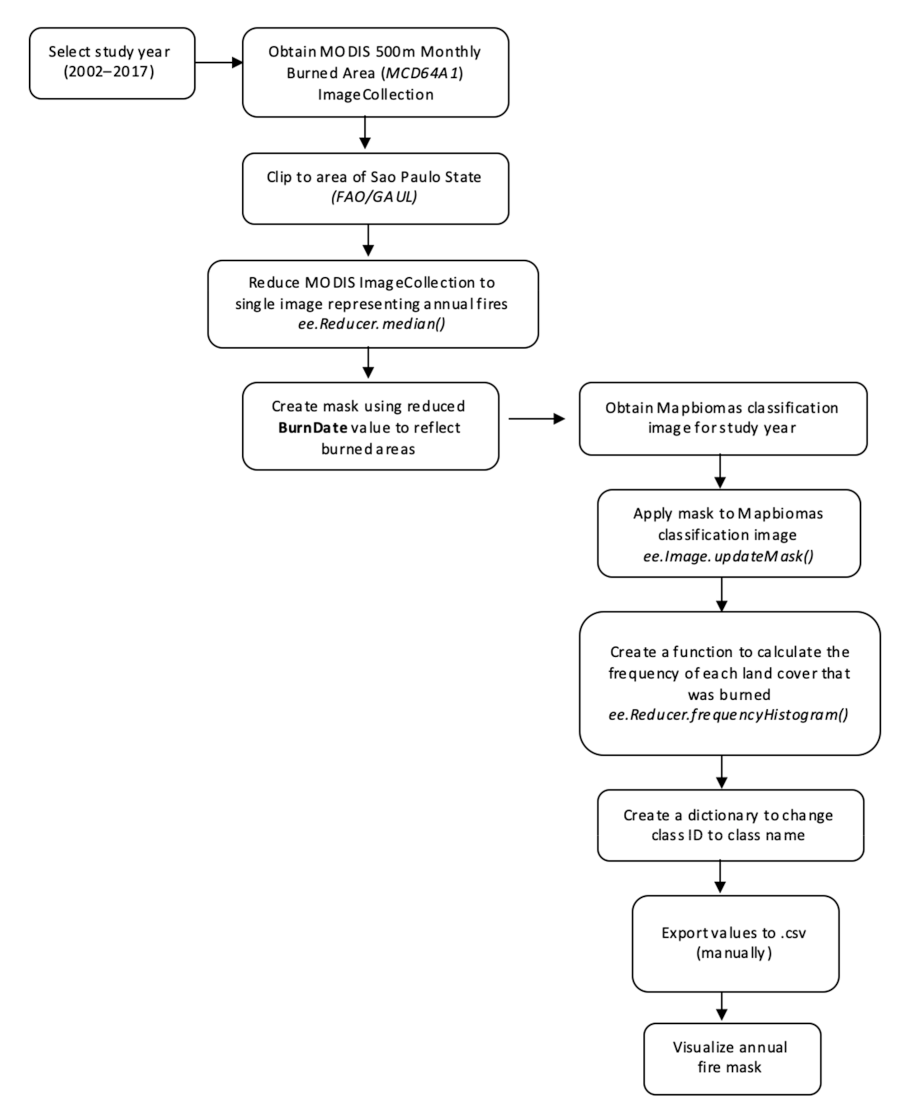
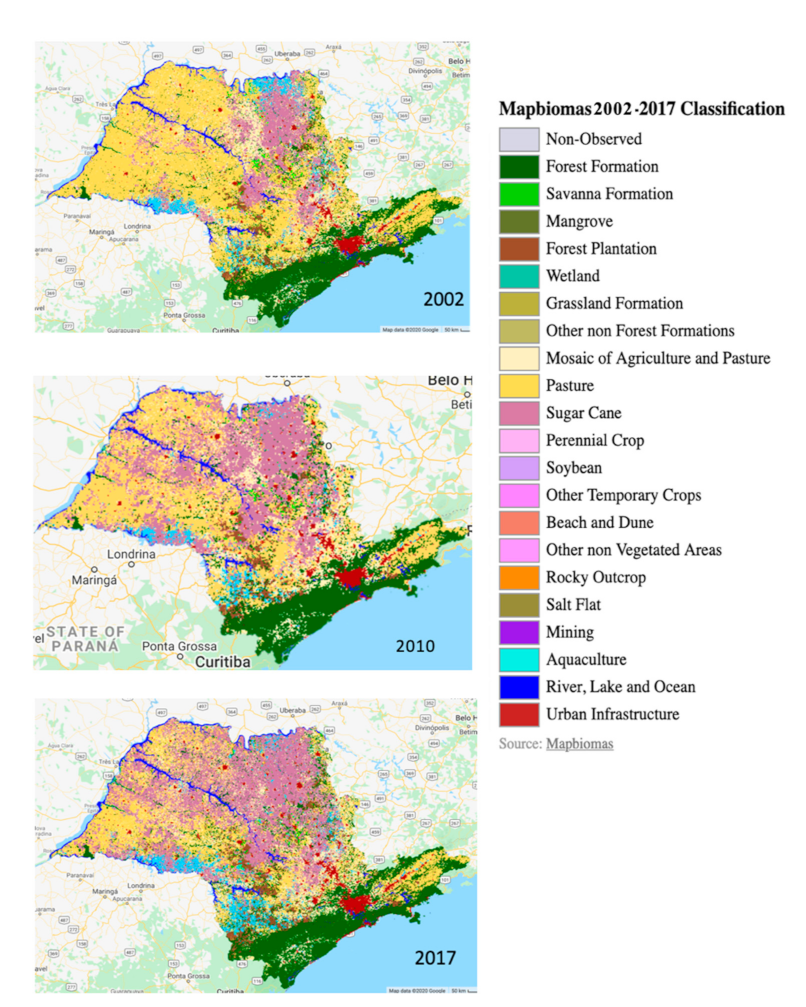
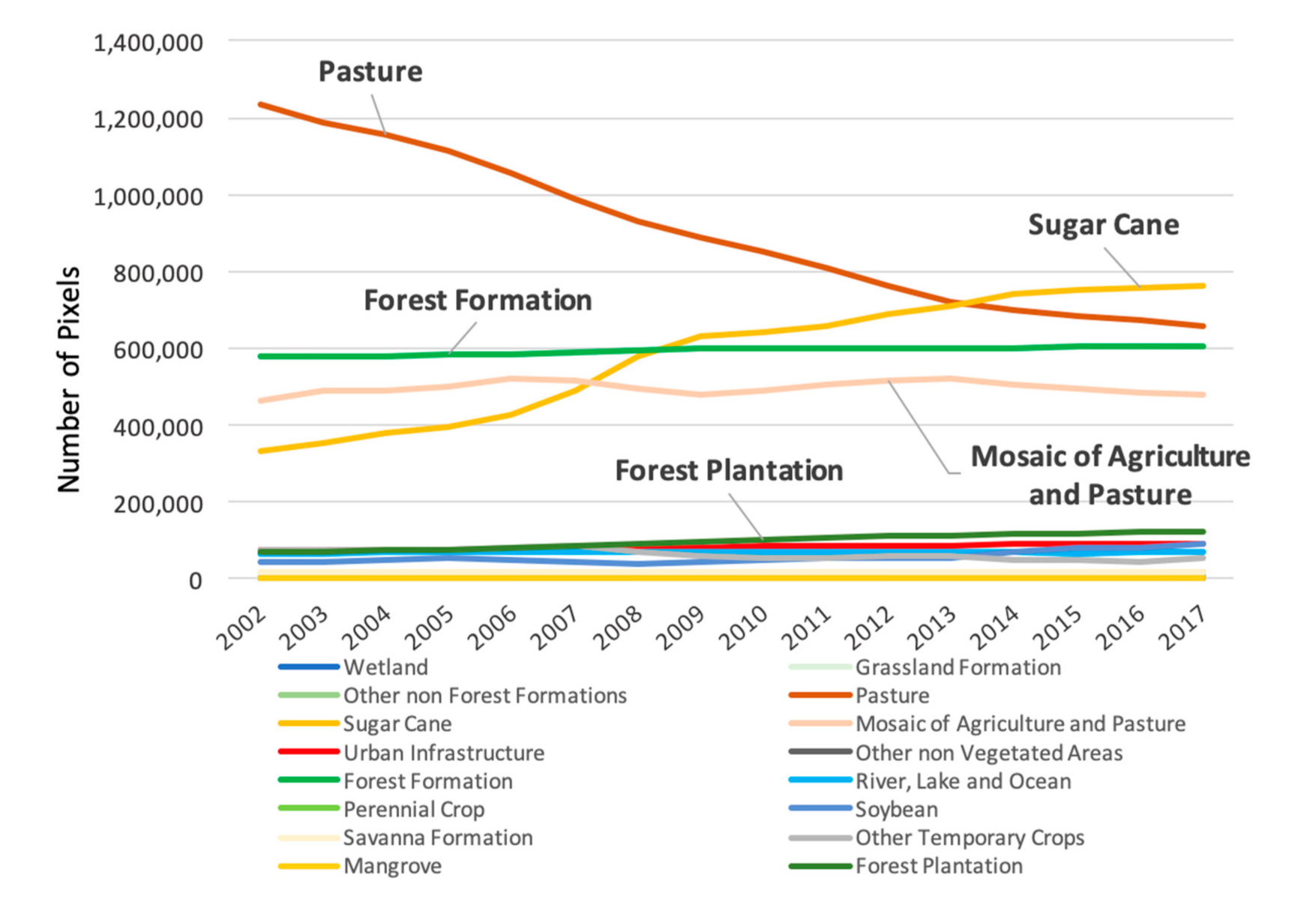
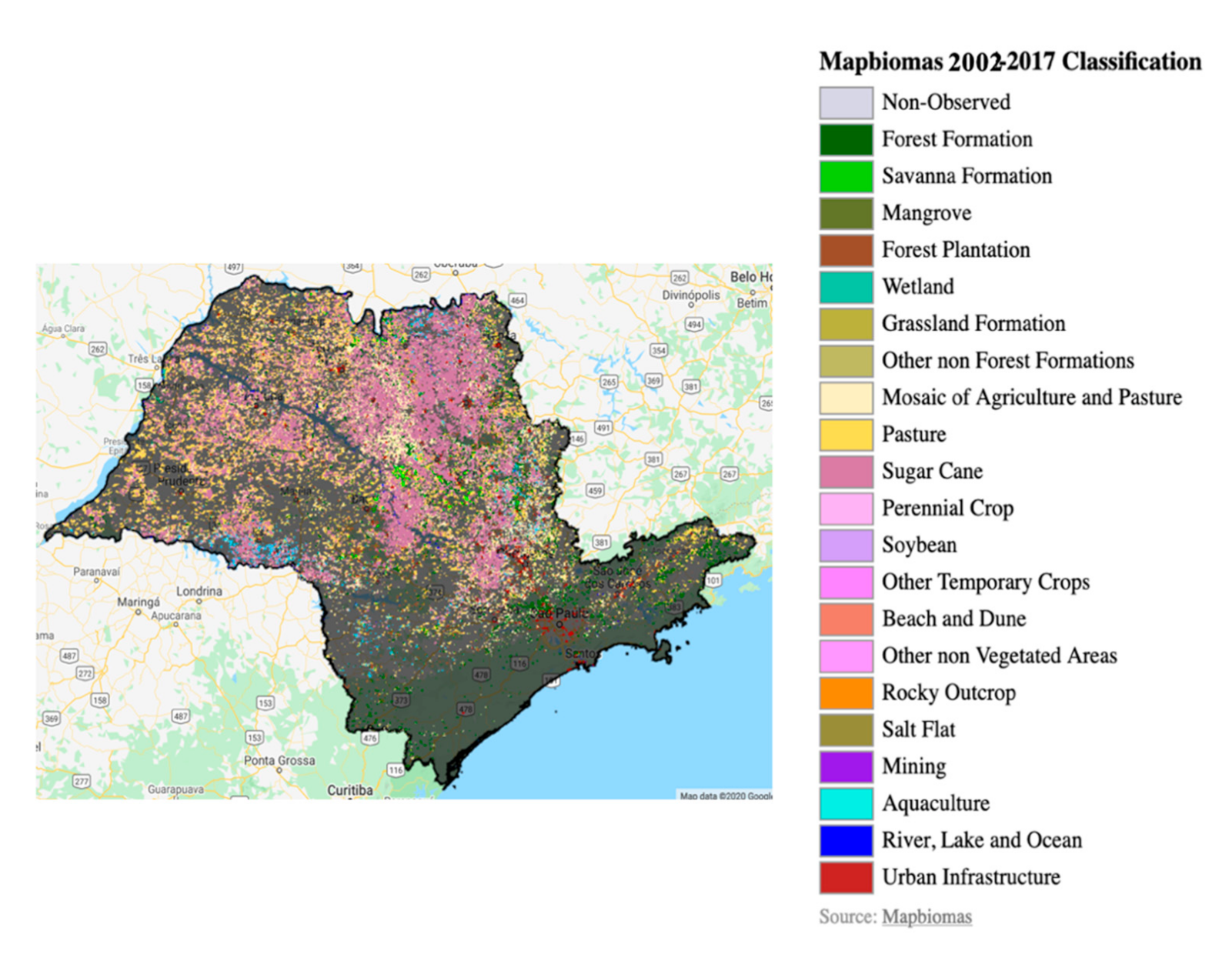

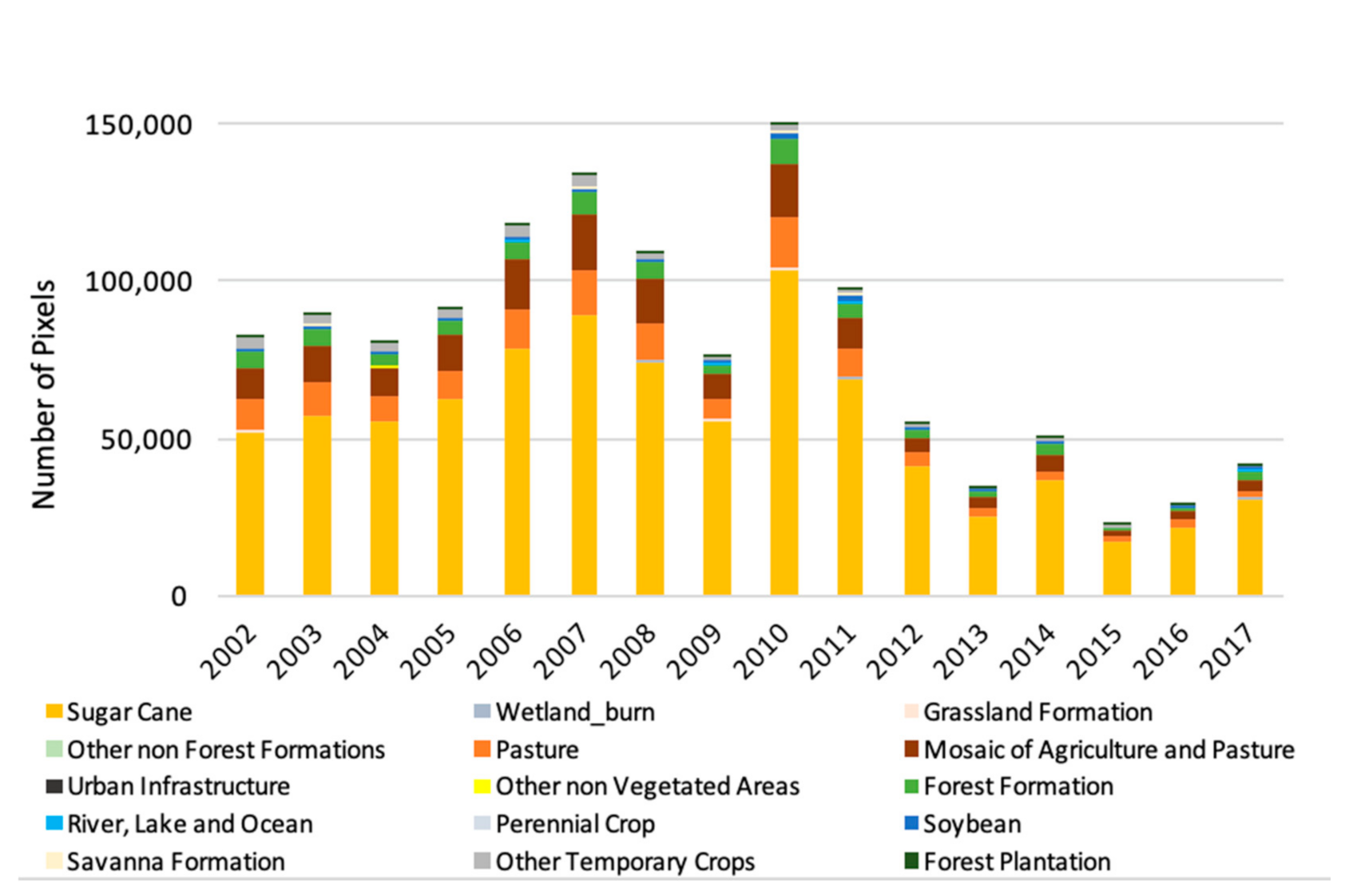



| 2002 (a) | 2003 (a) | 2004 (b) | 2005 (b) | 2006 (b) | 2007 (b) | 2008 (b) | 2009 (b) | 2010 (c) | 2011 (c) | 2012 (c,d) | 2013 (c,d) | 2014 (c,d) | 2015 (c,d) | 2016 (d) | 2017 (d) |
|---|---|---|---|---|---|---|---|---|---|---|---|---|---|---|---|
| 3117.6 | 3312.8 | 3414.2 | 3673.3 | 4258.4 | 4835.4 | 5411.3 | 5538.9 | 5135.3 | 5269.4 | 5355.7 | 5501.9 | 5539.7 | 5605.7 | 5569.2 | 5601.2 |
| Land Use Classification Type | 2002 | 2003 | 2004 | 2005 | 2006 | 2007 | 2008 | 2009 | 2010 | 2011 | 2012 | 2013 | 2014 | 2015 | 2016 | 2017 |
|---|---|---|---|---|---|---|---|---|---|---|---|---|---|---|---|---|
| Pasture | 41% | 40% | 39% | 37% | 35% | 33% | 31% | 30% | 28% | 27% | 25% | 24% | 23% | 23% | 23% | 22% |
| Sugar Cane | 11% | 12% | 13% | 13% | 14% | 16% | 19% | 21% | 22% | 22% | 23% | 24% | 25% | 25% | 25% | 26% |
| Mosaic of Agriculture and Pasture | 16% | 16% | 16% | 17% | 17% | 17% | 16% | 16% | 16% | 17% | 17% | 17% | 17% | 16% | 16% | 16% |
| Soybean | 1% | 2% | 2% | 2% | 2% | 2% | 1% | 1% | 2% | 2% | 2% | 2% | 2% | 3% | 3% | 3% |
| Other Temporary Crops | 3% | 3% | 3% | 2% | 3% | 3% | 2% | 2% | 2% | 2% | 2% | 2% | 2% | 2% | 2% | 2% |
| River, Lake and Ocean | 2% | 2% | 2% | 2% | 2% | 2% | 2% | 2% | 2% | 2% | 2% | 2% | 2% | 2% | 2% | 2% |
| Forest Formation | 19% | 19% | 19% | 19% | 20% | 20% | 20% | 20% | 20% | 20% | 20% | 20% | 20% | 20% | 20% | 20% |
| Forest Plantation | 2% | 2% | 2% | 3% | 3% | 3% | 3% | 3% | 3% | 4% | 4% | 4% | 4% | 4% | 4% | 4% |
| Savanna Formation | 1% | 1% | 1% | 1% | 1% | 1% | 1% | 1% | 1% | 1% | 1% | 1% | 1% | 1% | 1% | 1% |
| Land Use Classification Type | 2002 | 2003 | 2004 | 2005 | 2006 | 2007 | 2008 | 2009 | 2010 | 2011 | 2012 | 2013 | 2014 | 2015 | 2016 | 2017 |
|---|---|---|---|---|---|---|---|---|---|---|---|---|---|---|---|---|
| Pasture | 12% | 12% | 9% | 10% | 10% | 11% | 11% | 9% | 11% | 9% | 7% | 7% | 6% | 7% | 7% | 5% |
| Sugar Cane | 63% | 64% | 68% | 68% | 66% | 66% | 68% | 73% | 69% | 71% | 75% | 73% | 72% | 76% | 74% | 73% |
| Mosaic of Agriculture & Pasture | 13% | 12% | 11% | 13% | 14% | 13% | 12% | 10% | 11% | 11% | 9% | 12% | 9% | 8% | 9% | 9% |
| Soybean | 1% | 1% | 1% | 1% | 1% | 1% | 1% | 1% | 1% | 2% | 1% | 1% | 1% | 1% | 1% | 2% |
| Other Temporary Crops | 4% | 3% | 3% | 3% | 3% | 3% | 2% | 1% | 1% | 1% | 2% | 2% | 1% | 1% | 1% | 2% |
| Forest Formation | 6% | 6% | 5% | 4% | 5% | 5% | 5% | 4% | 5% | 4% | 4% | 5% | 7% | 5% | 4% | 6% |
| Forest Plantation | 1% | 0% | 0% | 0% | 0% | 0% | 0% | 0% | 0% | 0% | 1% | 1% | 1% | 1% | 1% | 1% |
| Savanna Formation | 1% | 0% | 1% | 0% | 0% | 0% | 0% | 0% | 0% | 0% | 0% | 0% | 0% | 0% | 1% | 0% |
| Sugarcane n = 16 | |
|---|---|
| Pasture | −0.993 ** |
| Forest Formation | 0.984 ** |
| Forest Plantation | 0.985 ** |
| Gross Added Value (GVA) Agriculture | 0.877 ** |
| Gross Domestic Product (GDP) | 0.963 ** |
| Total Planted | 0.946 ** |
| 2002–2017 | 2002–2008 | 2009–2011 | 2012–2017 | |
|---|---|---|---|---|
| Burn_Sugar n = 16 | Burn_Sugar n = 7 | Burn_Sugar n = 3 | Burn_Sugar n = 6 | |
| Pasture Burned | 0.966 ** | 0.880 ** | 0.994 | 0.946 ** |
| Mosaic Burned | 0.963 ** | 0.968 ** | 1.00 ** | 0.937 ** |
| Total Burned | 0.996 ** | 0.991 ** | 1.00 ** | 0.999 ** |
| GVA Agriculture | −0.546 * | 0.989 ** | −0.999 * | −0.282 |
| GDP | −0.617 * | 0.851 * | 0.319 | −0.517 |
Publisher’s Note: MDPI stays neutral with regard to jurisdictional claims in published maps and institutional affiliations. |
© 2021 by the authors. Licensee MDPI, Basel, Switzerland. This article is an open access article distributed under the terms and conditions of the Creative Commons Attribution (CC BY) license (https://creativecommons.org/licenses/by/4.0/).
Share and Cite
Philogene, S.; Ni-Meister, W. Relationship between Fire Events and Land Use Changes in the State of São Paulo, Brazil. Remote Sens. 2021, 13, 2853. https://doi.org/10.3390/rs13152853
Philogene S, Ni-Meister W. Relationship between Fire Events and Land Use Changes in the State of São Paulo, Brazil. Remote Sensing. 2021; 13(15):2853. https://doi.org/10.3390/rs13152853
Chicago/Turabian StylePhilogene, Sheena, and Wenge Ni-Meister. 2021. "Relationship between Fire Events and Land Use Changes in the State of São Paulo, Brazil" Remote Sensing 13, no. 15: 2853. https://doi.org/10.3390/rs13152853
APA StylePhilogene, S., & Ni-Meister, W. (2021). Relationship between Fire Events and Land Use Changes in the State of São Paulo, Brazil. Remote Sensing, 13(15), 2853. https://doi.org/10.3390/rs13152853






